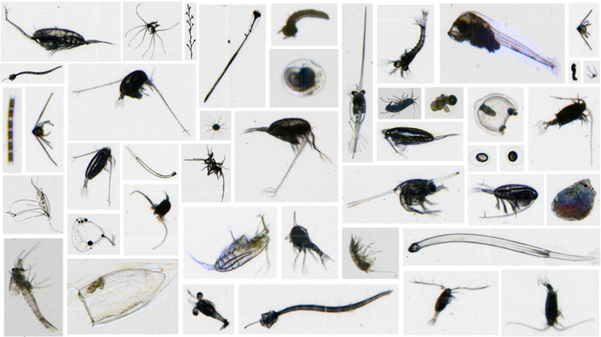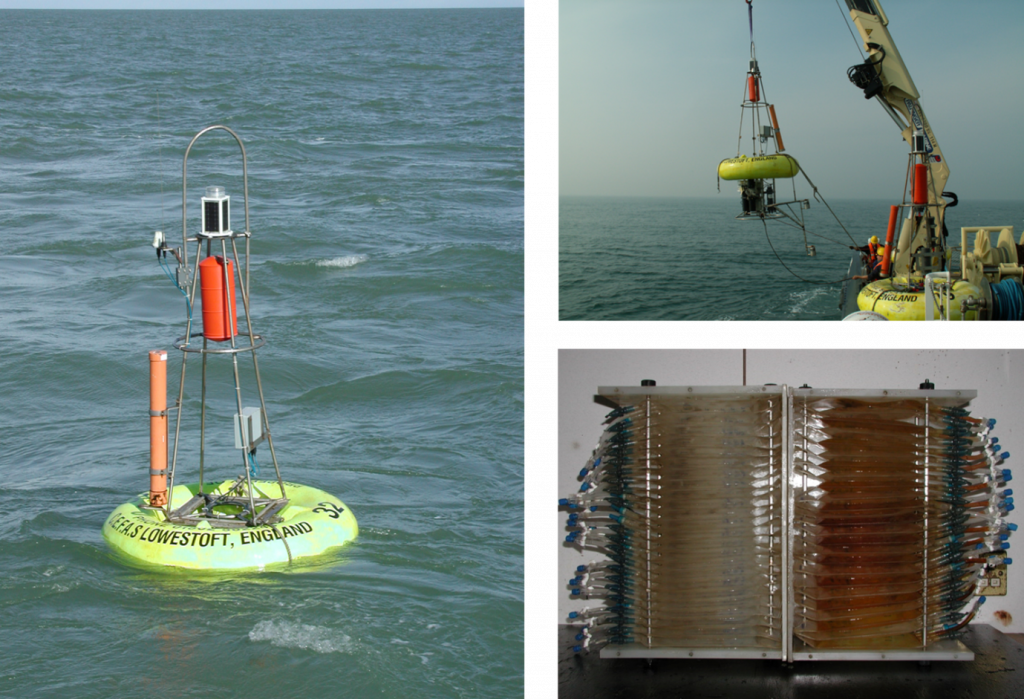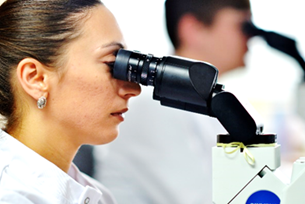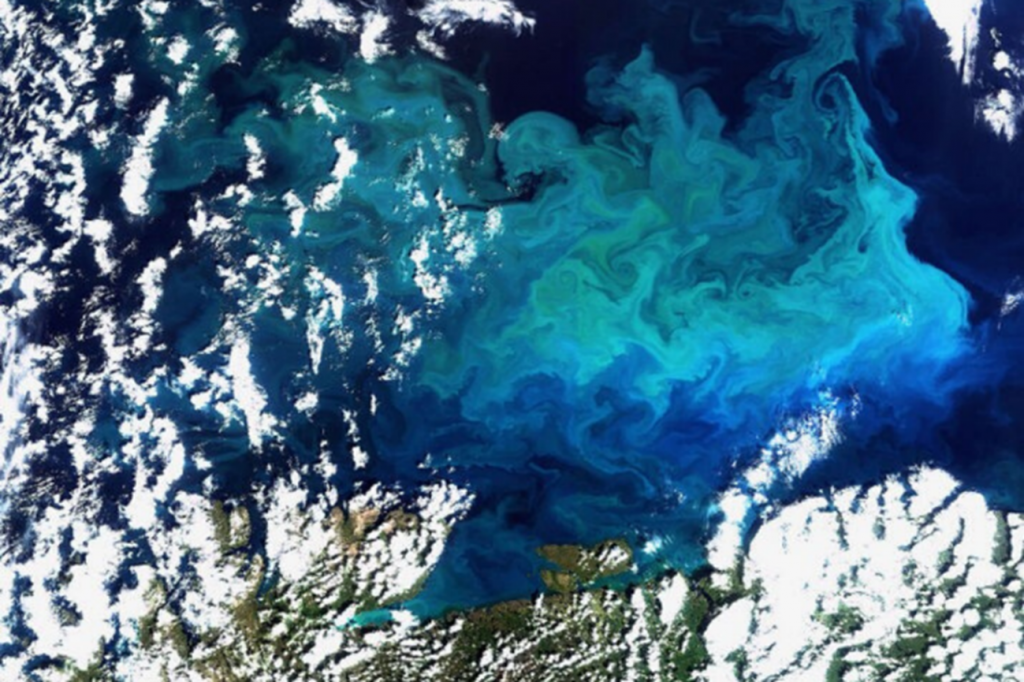Microscopic plankton form the base of the marine food webs. Yet they are often the “forgotten” element in marine ecosystems despite having the critical role of supporting all other life. Cefas’ plankton scientists maintain long-term observational records of marine plankton alongside developing new technologies to improve monitoring of this key collection of organisms.

Plankton are called the drifters of the oceans as they have limited ability to propel themselves. They are a diverse collection of organisms including phytoplankton (plankton that is capable of photosynthesis), zooplankton (animal plankton), and bacterioplankton (bacteria). Though the vast majority of plankton are microscopic and invisible to the naked eye, they cover a wide range of sizes including large organisms such as jellyfish.
As the base of the food chain, plankton provide a crucial source of food, directly and indirectly, to many small and large animals like fish and whales. Observing and understanding the plankton is key to assessing the health of the marine environment. The total number of individual plankton (their abundance) and different plankton species (their community structure) are sensitive to pressures like changes in temperature (climate) and certain pollutants (nutrients). Plankton abundance and community structure often respond quickly to these pressures. This makes them good indicators for the status of the marine environment. For example, plankton indicators are used at the UK scale in the UK Marine Strategy and within the 25 Year Environment Plan at a regional sea scale for OSPAR.
Since 2001, Cefas have used SmartBuoys to collect water samples for measurements of phytoplankton abundance and community analysis at strategic locations around the UK coast. These samples are recovered during surveys aboard the Research Vessel Cefas Endeavour and returned to the laboratory where the phytoplankton species are identified and counted under a microscope. Alongside the water samplers SmartBuoys have several sensors which measure the properties of the water including chlorophyll fluorescence: an optical measurement which is directly related to phytoplankton abundance. We look for changes in the phytoplankton observed in the samples and by the sensors in response to changes in nutrients and other human pressures.
Phytoplankton are being used by UK agencies as an indicator of anthropogenic (human-driven) inputs of nutrients, mainly from inorganic nitrogen, under many environmental directives. They are a crucial part of our toolbox in understanding human impacts on the marine environment, and so the plankton monitoring programme reveals much about the wider health of our seas.

Cefas work in partnership with other institutes to build a broader understanding of plankton health, which impacts the health of the whole marine ecosystem. The plankton community structure sampled by the SmartBuoys is used alongside other UK plankton observations in Pelagic Habitat assessment. This assessment groups the many species into a set of ‘lifeforms’ by common ecosystem function: all UK plankton lifeform data are now publicly available through the lifeform data tool.
Changes in how plankton are monitored can make it harder to identify changes: is a trend due to a change in the environment, or a change in the sampling or laboratory method? But plankton identification by microscopy is labour intensive. While expert taxonomists cannot be replaced, their work can be complemented by several new plankton observation methods which can provide information at finer scales in space and time.
The Plankton Imager is an all-in-one system which combines continuous sampling with near-real-time analysis. The Imager is installed on a ship and connected to a water supply which continuously pumps surface seawater into the instrument. An image is captured of every particle between 0.01 and 20 mm in size. These particles are then identified and classified to the lowest taxonomical resolution possible.
Sophie Pitois, Senior Plankton Ecologist at Cefas, said, “The Plankton Imager is one of the latest developments in plankton monitoring, its ongoing development is led by Cefas with Plankton Analytics Ltd, Plymouth (UK). It has allowed us to collect data at a resolution never seen before to obtain more complete and integrated ecosystem information.”

Another plankton monitoring technology which is used is connected to the RV Cefas Endeavour’s water supply to collect high frequency information on the plankton community is the flow cytometer Cytosense. Every year, during the October PELTIC survey in the in the Celtic Sea flow cytometry is used to perform 1572 analyses, counting around 60 million phytoplanktonic particles and characterising them by 66 parameters such size and pigment composition. One advantage of the technology is its ability to capture the smaller sized plankton: from less than 0.002 mm and up to more than 0.2 mm.
This type of instrument has been used on coastal platforms and ships of opportunity like ferries for the last 10 years. Cefas’ use of flow cytometry to monitor plankton feeds into European collaboration such as the Joint European Research Infrastructure of Coastal Observatories: Science, Service, Sustainability (JERICO-S3) programme.
Véronique Créach, Senior Marine Ecologist at Cefas, said, “Because of the daily variability in their population dynamics and their patchy distribution in the sea, only technology such as the in-situ high frequency measurement with an autonomous instrument such as flow cytometry Cytosense can give us suitable data on phytoplankton diversity and biomass across our seas”.
Despite most being microscopic at an individual scale, images of plankton can also be taken from space using sensors on satellites orbiting the earth. These ‘remote sensing’ data can be used to monitor plankton across larger areas and with greater frequency than traditional sampling from ships. This data is beginning to be used in marine assessments but requires careful calibration (comparison) to traditional measurements to ensure it is robust and fit for purpose.

Michelle Devlin, Cefas Science Theme Lead for Environment and People, says, “Plankton are more important than most people realise. They are some of the smallest living things on Earth, but they influence the climate of the whole planet. They are the most abundant form of life in the oceans, in both weight and sheer numbers.
"They are responsible for up to 50% of global primary production, which means every second breath you take is thanks to plankton. They are the basis of the food web, and without them, we would struggle to have enough to eat. They are sensitive to environmental changes, particularly pollution and climate change and can be valuable indicators of how we impact on our marine areas. Our work will continue to look at the structure of those plankton communities, how they change over time and how they respond to the impacts of our human activities.”
Collaborators:
Plankton Analytics Ltd, Plymouth (UK)
UK Pelagic Habitats Expert Group:
- Plankton and Policy Group, University of Plymouth
- UK Environment Agency
- Marine Scotland Science
- Marine Biological Association
- Plymouth Marine Laboratories
- Scottish Association for Marine Science
- Scottish Environment Protection Agency
- Agri-Food and Biosciences Institute
Recent Relevant Publications:
Pitois and others, 2021: A first approach to build and test the Copepod Mean Size and Total Abundance (CMSTA) ecological indicator using in-situ size measurements from the Plankton Imager (PI), in Ecological Indicators. https://doi.org/10.1016/j.ecolind.2020.107307
Bedford and others, 2020: Lifeform indicators reveal large‐scale shifts in plankton across the North‐West European shelf, in Global Change Biology. https://doi.org/10.1111/gcb.15066.
Greenwood and others, 2019: Utilizing eutrophication assessment directives from transitional to marine systems in the Thames Estuary and Liverpool Bay, UK, in Frontiers in Marine Science. https://doi.org/10.3389/fmars.2019.00116.